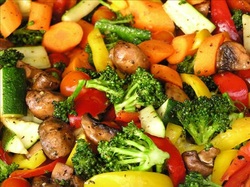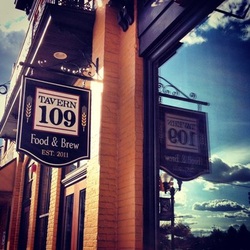
Vegetarian Cookbook Project
“Nothing will benefit human health and increase chances for survival of life on Earth as much as the evolution to a vegetarian diet”, wrote Albert Einstein. Vegetarianism in its most basic definition is a diet excluding meat; from these basic guidelines stem many different variations of vegetarianism. The arguments for a vegetarian diet vary widely, and here are just a few of the reasons: religion, animal rights, cultural preferences, money or even feminism. One of the most popular arguments for a vegetarian diet is the positive health effects. These health effects are not just based on the health of the individual vegetarian, but on the environmental health of the world. Although the argument for the health of the individual has been around for a while the overall health of the environment argument is one that has grown from the industrialization of the food system.
To get a better understanding for the argument supporting the health benefits of vegetarianism, vegetarian cookbooks are good resources to look at to find a variety of arguments. Vegetarianism for the Working Person is a cookbook/guidebook for how to cook simple vegetarian dishes and it is also a guide of where to find vegetarian options on the go. This book was written in the mid 1980’s; it argues, almost exclusively, about the individual health benefits. The author’s goal was to inform the reader that vegetarianism can be an actual long-term diet. “The American Dietetic Association has affirmed that a vegetarian diet can meet all known nutrient needs” (Stahler). The prevailing thought amongst most people during this time was that meat products were needed to have a complete diet and to eat a meatless diet would be bad for your health. The cookbook makes no arguments about environmental health benefits. During the, mid-1980’s the industrial food system was booming, but the negative externalities of the system had yet to be fully realized. The cookbook actually supports the use of the industrialized food system; the first quarter of the book is devoted to finding vegetarian options at different places, mostly fast food restaurants. The industrialized food system was in full swing during this time, but the harmful short term and long term effects had not been realized.
To find out how the health argument had changed since the mid-1980’s, two other cookbooks were analyzed. One from 1995, Linda’s Kitchen: Simple and Inspiring Recipes for Meatless Meals ,and the other was a book originally written in 1997 called Student's Vegetarian Cookbook: Quick, Easy, Cheap, and Tasty Vegetarian Recipes. Both of these cookbooks present the argument of health as the main reason for becoming a vegetarian, but they present their arguments to a different crowd and in a different manner. Student’s Vegetarian Cookbook was written for students who are beginning their journey into vegetarianism who are looking for quicker and more simple recipes to make while balancing the life of a student. The cookbook’s author mostly talks about the negative environmental health effects of eating meat, and how if you eliminate meat from your diet it can help the world, as well as yourself. The cookbook has a strong underlying tone portraying the “evilness” of the current food industry, arguing that it is not sustainable and it uses many statistics to show its negative effects.
Linda’s Kitchen argued much of the same as Student’s Vegetarian Cookbook, except it felt as if it was geared to a more sophisticated crowd than students. The recipes seemed gourmet and more complicated to make than the previous two cookbooks. The author Linda McCarthy stressed that becoming a vegetarian was a great new way of life that not only would help to save your life but also the planet’s. She rejected the industrial food system, and made sure the reader knew that the current way of producing food specifically meat was unsustainable.
The most interesting part of the three cookbooks is the addition of the environmental health argument from the earlier cookbook as opposed the two cookbooks from the mid to late 1990’s. The earlier cookbook actually advocated using the industrialized food system to help be a “working person” vegetarian, by using fast food restaurants to eat vegetarian. A lot of knowledge was gained in that ten year period between the books and that can be seen. Although there is still some skepticism, mostly among staunch meat eaters, of a vegetarian diet being a complete healthy diet. The latter two cookbooks featured environmental arguments for becoming a vegetarian rather than just strictly the individual health. The vegetarian diet, according to the health argument presented in the cookbooks has become an anti-industrial food movement, pushing vegetarians to reject the food industry.
Works Cited
McCartney, Linda. Linda's Kitchen: Simple and Inspiring Recipes for Meatless Meals. New York: Arcade Pub, 1995. Print.
Stahler, Charles, and Debra Wasserman. Vegetarianism for the Working Person: Quick and Easy Vegetarian Recipes. Baltimore, MD: Baltimore Vegetarians, 1986. Print.
Raymond, Carole. Student's Vegetarian Cookbook: Quick, Easy, Cheap, and Tasty Vegetarian Recipes. New York: Three Rivers Press, 2003. Print.
“Nothing will benefit human health and increase chances for survival of life on Earth as much as the evolution to a vegetarian diet”, wrote Albert Einstein. Vegetarianism in its most basic definition is a diet excluding meat; from these basic guidelines stem many different variations of vegetarianism. The arguments for a vegetarian diet vary widely, and here are just a few of the reasons: religion, animal rights, cultural preferences, money or even feminism. One of the most popular arguments for a vegetarian diet is the positive health effects. These health effects are not just based on the health of the individual vegetarian, but on the environmental health of the world. Although the argument for the health of the individual has been around for a while the overall health of the environment argument is one that has grown from the industrialization of the food system.
To get a better understanding for the argument supporting the health benefits of vegetarianism, vegetarian cookbooks are good resources to look at to find a variety of arguments. Vegetarianism for the Working Person is a cookbook/guidebook for how to cook simple vegetarian dishes and it is also a guide of where to find vegetarian options on the go. This book was written in the mid 1980’s; it argues, almost exclusively, about the individual health benefits. The author’s goal was to inform the reader that vegetarianism can be an actual long-term diet. “The American Dietetic Association has affirmed that a vegetarian diet can meet all known nutrient needs” (Stahler). The prevailing thought amongst most people during this time was that meat products were needed to have a complete diet and to eat a meatless diet would be bad for your health. The cookbook makes no arguments about environmental health benefits. During the, mid-1980’s the industrial food system was booming, but the negative externalities of the system had yet to be fully realized. The cookbook actually supports the use of the industrialized food system; the first quarter of the book is devoted to finding vegetarian options at different places, mostly fast food restaurants. The industrialized food system was in full swing during this time, but the harmful short term and long term effects had not been realized.
To find out how the health argument had changed since the mid-1980’s, two other cookbooks were analyzed. One from 1995, Linda’s Kitchen: Simple and Inspiring Recipes for Meatless Meals ,and the other was a book originally written in 1997 called Student's Vegetarian Cookbook: Quick, Easy, Cheap, and Tasty Vegetarian Recipes. Both of these cookbooks present the argument of health as the main reason for becoming a vegetarian, but they present their arguments to a different crowd and in a different manner. Student’s Vegetarian Cookbook was written for students who are beginning their journey into vegetarianism who are looking for quicker and more simple recipes to make while balancing the life of a student. The cookbook’s author mostly talks about the negative environmental health effects of eating meat, and how if you eliminate meat from your diet it can help the world, as well as yourself. The cookbook has a strong underlying tone portraying the “evilness” of the current food industry, arguing that it is not sustainable and it uses many statistics to show its negative effects.
Linda’s Kitchen argued much of the same as Student’s Vegetarian Cookbook, except it felt as if it was geared to a more sophisticated crowd than students. The recipes seemed gourmet and more complicated to make than the previous two cookbooks. The author Linda McCarthy stressed that becoming a vegetarian was a great new way of life that not only would help to save your life but also the planet’s. She rejected the industrial food system, and made sure the reader knew that the current way of producing food specifically meat was unsustainable.
The most interesting part of the three cookbooks is the addition of the environmental health argument from the earlier cookbook as opposed the two cookbooks from the mid to late 1990’s. The earlier cookbook actually advocated using the industrialized food system to help be a “working person” vegetarian, by using fast food restaurants to eat vegetarian. A lot of knowledge was gained in that ten year period between the books and that can be seen. Although there is still some skepticism, mostly among staunch meat eaters, of a vegetarian diet being a complete healthy diet. The latter two cookbooks featured environmental arguments for becoming a vegetarian rather than just strictly the individual health. The vegetarian diet, according to the health argument presented in the cookbooks has become an anti-industrial food movement, pushing vegetarians to reject the food industry.
Works Cited
McCartney, Linda. Linda's Kitchen: Simple and Inspiring Recipes for Meatless Meals. New York: Arcade Pub, 1995. Print.
Stahler, Charles, and Debra Wasserman. Vegetarianism for the Working Person: Quick and Easy Vegetarian Recipes. Baltimore, MD: Baltimore Vegetarians, 1986. Print.
Raymond, Carole. Student's Vegetarian Cookbook: Quick, Easy, Cheap, and Tasty Vegetarian Recipes. New York: Three Rivers Press, 2003. Print.

 RSS Feed
RSS Feed